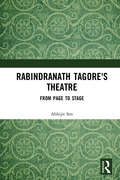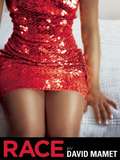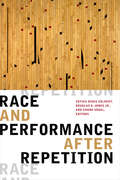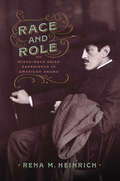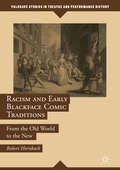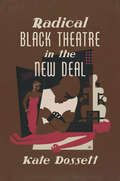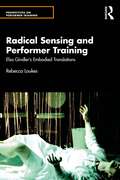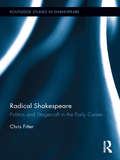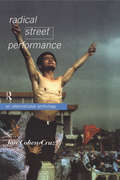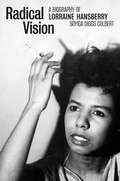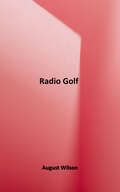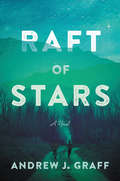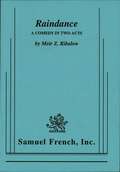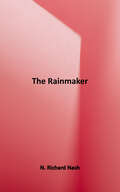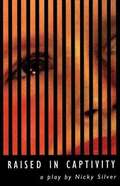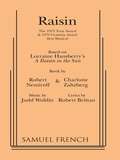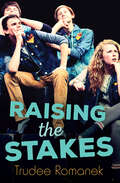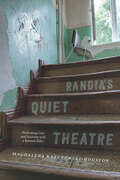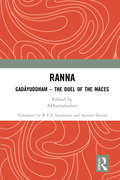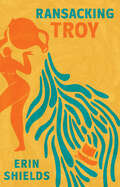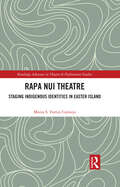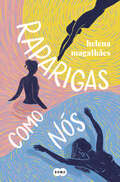- Table View
- List View
Rabindranath Tagore's Theatre: From Page to Stage
by Abhijit SenThis book analyses Rabindranath Tagore’s contribution to Bengali drama and theatre. Throughout this book, Abhijit Sen locates and studies Rabindranath’s experiments with drama/theatre in the context of the theatre available in nineteenth-century Bengal, and explores the innovative strategies he adopted to promote his ‘brand’ of theatre. This approach finds validation in the fact that Rabindranath combined in himself the roles of author-actor-producer, who always felt that, without performance, his dramatic compositions fell short of the desired completeness. Various facets of his plays as theatre and his own role as a theatre-practitioner are the prime focus of this book. This book will be of great interest to students and scholars in Theatre and Performance Studies and most notably, those focusing on Indian Theatre and Postcolonial Theatre.
Race
by David Mamet"Gripping. . . . Deep in its gut, Mamet's new play argues, everything in America-and this play throws in sex, rape, the law, employment and relationships-is still about race."-Chicago Tribune"A dramatist celebrated for introducing expletives to the American theatre now tackles a truly taboo four-letter word. . . . Most concerned with the power and treachery of language, Mamet remains American theatre's most urgent five-letter word."-GuardianDavid Mamet, who took on the subject of sexual harassment with his 1992 drama Oleanna, has once again ignited controversy, hitting the hot-button issue of our so-called post-racial society. When a rich white man is accused of raping a younger African American woman, he looks to a multicultural law firm for his defense. But even as his lawyers-one of them white, another black-begin to strategize, they must confront their own biases and assumptions about race relations in America. Currently playing to acclaim on Broadway in a production directed by Mamet, audience members may be moved to self-scrutiny by his signature gritty yet finely tuned language.David Mamet is a playwright, director, author, essayist, screenwriter, and film director. He was awarded a Pulitzer Prize for Glengarry Glen Ross, which also received a Tony Award nomination, along with Speed-the-Plow. Other of his plays include American Buffalo, Oleanna, and The Cryptogram.
Race and Performance after Repetition
by Soyica Diggs Colbert, Douglas A. Jones Jr., and Shane VogelThe contributors to Race and Performance after Repetition explore how theater and performance studies account for the complex relationship between race and time. Pointing out that repetition has been the primary point of reference for understanding both the complex temporality of theater and the historical persistence of race, they identify and pursue critical alternatives to the conceptualization, organization, measurement, and politics of race in performance. The contributors examine theater, performance art, music, sports, dance, photography, and other forms of performance in topics that range from the movement of boxer Joe Louis to George C. Wolfe's 2016 reimagining of the 1921 all-black musical comedy Shuffle Along to the relationship between dance, mourning, and black adolescence in Flying Lotus's music video “Never Catch Me.” Proposing a spectrum of coexisting racial temporalities that are not tethered to repetition, this collection reconsiders central theories in performance studies in order to find new understandings of race.Contributors. Joshua Chambers-Letson, Soyica Diggs Colbert, Nicholas Fesette, Patricia Herrera, Jasmine Elizabeth Johnson, Douglas A. Jones Jr., Mario LaMothe, Daphne P. Lei, Jisha Menon, Tavia Nyong’o, Tina Post, Elizabeth W. Son, Shane Vogel, Catherine M. Young, Katherine Zien
Race and Role: The Mixed-Race Asian Experience in American Drama
by Rena M. HeinrichMixed-race Asian American plays are often overlooked for their failure to fit smoothly into static racial categories, rendering mixed-race drama inconsequential in conversations about race and performance. Since the nineteenth century, however, these plays have long advocated for the social significance of multiracial Asian people. Race and Role: The Mixed-Race Experience in American Drama traces the shifting identities of multiracial Asian figures in theater from the late-nineteenth century to the present day and explores the ways that mixed-race Asian identity transforms our understanding of race. Mixed-Asian playwrights harness theater’s generative power to enact performances of “double liminality” and expose the absurd tenacity with which society clings to a tenuous racial scaffolding.
Racism and Early Blackface Comic Traditions: From the Old World to the New (Palgrave Studies in Theatre and Performance History)
by Robert HornbackThis book traces blackface types from ancient masks of grinning Africans and phallus-bearing Roman fools through to comedic medieval devils, the pan-European black-masked Titivillus and Harlequin, and racial impersonation via stereotypical 'black speech' explored in the Renaissance by Lope de Vega and Shakespeare. Jim Crow and antebellum minstrelsy recycled Old World blackface stereotypes of irrationality, ignorance, pride, and immorality. Drawing upon biblical interpretations and philosophy, comic types from moral allegory originated supposedly modern racial stereotypes. Early blackface traditions thus spread damning race-belief that black people were less rational, hence less moral and less human. Such notions furthered the global Renaissance’s intertwined Atlantic slave and sugar trades and early nationalist movements. The latter featured overlapping definitions of race and nation, as well as of purity of blood, language, and religion in opposition to 'Strangers'. Ultimately, Old World beliefs still animate supposed 'biological racism' and so-called 'white nationalism' in the age of Trump.
Radical Black Theatre in the New Deal (The John Hope Franklin Series in African American History and Culture)
by Kate DossettBetween 1935 and 1939, the United States government paid out-of-work artists to write, act, and stage theatre as part of the Federal Theatre Project (FTP), a New Deal job relief program. In segregated "Negro Units" set up under the FTP, African American artists took on theatre work usually reserved for whites, staged black versions of "white" classics, and developed radical new dramas. In this fresh history of the FTP Negro Units, Kate Dossett examines what she calls the black performance community—a broad network of actors, dramatists, audiences, critics, and community activists—who made and remade black theatre manuscripts for the Negro Units and other theatre companies from New York to Seattle. Tracing how African American playwrights and troupes developed these manuscripts and how they were then contested, revised, and reinterpreted, Dossett argues that these texts constitute an archive of black agency, and understanding their history allows us to consider black dramas on their own terms. The cultural and intellectual labor of black theatre artists was at the heart of radical politics in 1930s America, and their work became an important battleground in a turbulent decade.
Radical Doubt: The Joker System, after Boal
by Mady SchutzmanRadical Doubt investigates ethical play across a spectrum of performances, on and off the stage. In witty, recursive, personal, and propulsive prose, Mady Schutzman elaborates on the Joker System, conceived by Augusto Boal, best known for Theatre of the Oppressed. The Joker System is a collaborative approach to representing social dilemmas through a rare fusion of destabilizing ambiguity and journalistic rigor. Schutzman models the Joker System while expanding well beyond the theatrical. In polyphonic compositions that perform their own philosophy, she uncovers illuminating links between calculus and conjuring, kōans and resistance, humor and witnessing, complexity theory and sorely needed new practices of living in our divisive times. These life practices rely upon crafty and circuitous strategies to deliver their subversive punch. Jok(er)ing matters, Schutzman insists. When communities fragment and identities fixate, enter the trickster! Sonja KuftinecTheatre Arts and Dance, University of Minnesota
Radical Sensing and Performer Training: Elsa Gindler’s Embodied Translations (Perspectives on Performer Training)
by Rebecca LoukesThis exciting new book explores the pioneering radical sensing work of Elsa Gindler (1885–1961) and the practices of five women inspired by her. It re-considers a range of trajectories of influence across the established canons of twentieth-century performer training practices and challenges conventions of performer training historiography. Moving from the early twentieth‑century Physical Culture movement through Modern and Postmodern dance training in Europe and North America to contemporary devised theatre in the UK, this is the first book‑length study of Gindler’s pedagogy in relation to performance. It allows trainers, arts practitioners, theatre, dance and art historians, and students to understand previously untold stories in performance, Somatics and philosophies of knowledge. Bringing Gindler’s unique practice into dialogue with philosophies drawn from pragmatism and phenomenology, the book explores concepts of concentration and Gelassenheit, situation, gestalts of breathing, negative epistemology and phronesis, to create a picture of Elsa Gindler’s work as situated, context specific and inter‑subjective. It also explores how feminist ways of knowing and being are embedded in the practices themselves.Drawing on the author’s 30 years of experience of training in work inspired by Elsa Gindler, this book allows theories and practices to converse and merge to build a rich and multi‑dimensional perspective of performer training. Woven throughout are practical experiments for the reader to try, alongside analyses of performances and previously unpublished workshop material and notes. Beyond performance, this book locates Gindler’s work within wider contexts of social and ecological crises and suggests that this radical sensing practice can be used as a quiet way to make a difference in the world.
Radical Shakespeare: Politics and Stagecraft in the Early Career (Routledge Studies in Shakespeare)
by Chris FitterThis book argues that Shakespeare was permanently preoccupied with the brutality, corruption, and ultimate groundlessness of the political order of his state, and that the impact of original Tudor censorship, supplemented by the relatively depoliticizing aesthetic traditions of later centuries, have together obscured the consistent subversiveness of his work. Traditionally, Shakespeare’s political attitudes have been construed either as primarily conservative, or as essays in richly imaginative ambiguation, irreducible to settled viewpoints. Fitter contends that government censorship forced superficial acquiescence upon Shakespeare in establishment ideologies — monarchic, aristocratic and patriarchal — that were enunciated through rhetorical set pieces, but that Shakespeare the dramatist learned from Shakespeare the actor a variety of creative methods for sabotaging those perspectives in performance in the public theatres. Using historical contextualizations and recuperation of original performance values, the book argues that Shakespeare emerged as a radical writer not in middle age with King Lear and Coriolanus — plays whose radicalism is becoming widely recognized — but from his outset, with Henry VI and Taming of the Shrew. Recognizing Shakespeare’s allusiveness to 1590s controversies and dissident thought, and recovering the subtextual politics of Shakespeare’s distinctive stagecraft reveals populist, at times even radical meaning and a substantially new, and astonishingly interventionist, Shakespeare.
Radical Street Performance: An International Anthology
by Jan Cohen-CruzRadical Street Performance is the first volume to collect together the fascinating array of writings by activists, directors, performers, critics, scholars and journalists who have documented street theatre around the world. More than thirty essays explore the myriad forms this most public of performances can take: * agit-prop * invisible theatre * demonstrations and rallies * direct action * puppetry * parades and pageants * performance art * guerrilla theatre * circuses These essays look at performaces in Europe, Africa, China, India and both the Americas. They describe engagement with issues as diverse as abortion, colonialism, the environment and homophobia, to name only a few. Introduced by editor Jan Cohen-Cruz, the essays are organized into thematic sections: Agitating; Witnessing; Involving; Imagining; and Popularizing. Radical Street Performance is an inspiring testimony to this international performance phenomenon, and an invaluable record of a form of theatre which continues to flourish in a televisual age.
Radical Vision: A Biography of Lorraine Hansberry
by Soyica Diggs ColbertA &“loving, lavishly detailed&” (New York Times) and captivating portrait of Lorraine Hansberry&’s life, art, and political activism—one of O Magazine's best books of April 2021&“Hits the mark as a fresh and timely portrait of an influential playwright.&”—Publishers Weekly In this first scholarly biography of Lorraine Hansberry, Soyica Diggs Colbert narrates a life at the intersection of art and politics, arguing that for Hansberry the theater operated as a rehearsal room for her political and intellectual work. Celebrated for her play A Raisin in the Sun, Hansberry was also the author of innovative journalism and of plays touching on slavery, interracial communities, and Black freedom movements. Hansberry was deeply involved in the Black freedom struggle during the Cold War and in the early civil rights movement, and here Colbert shows us an artist&’s life with the background of the Greenwich Village art scene in the 1960s, the homophile movement, Black diasporic freedom movements, and third-wave feminism. Drawing from Hansberry&’s papers, speeches, and interviews, this book provides a new point of entry in the history of Black radicalism, and a new perspective on Black women in mid‑twentieth‑century political movements.
Radio Golf
by August WilsonA real-estate developer sets about trying to redevelop the 'blighted' Hill District of Pittsburgh in the final part of August Wilson's Century Cycle, his epic dramatisation of the African American experience in the twentieth century. Ivy League-educated Harmond Wilks has a plan to redevelop Pittsburgh's Hill District and hopes to become the town's first black mayor. But an old mansion slated for demolition, 1839 Wylie Avenue, turns out to have a significant past. 'I would encourage people to rave in the nonlinearity of his well-made plots, to big up his quirky architecture, to honor guard the house at 1839 Wylie so that it will always remain standing' Suzan-Lori Parks, from her Foreword.
Raft of Stars: A Novel
by Andrew J. Graff“A rousing adventure yarn full of danger and heart and humor.” —Richard RussoAn instant classic for fans of Jane Smiley and Kitchens of the Great Midwest: when two hardscrabble young boys think they’ve committed a crime, they flee into the Northwoods of Wisconsin. Will the adults trying to find and protect them reach them before it’s too late?It’s the summer of 1994 in Claypot, Wisconsin, and the lives of ten-year-old Fischer “Fish” Branson and Dale “Bread” Breadwin are shaped by the two fathers they don’t talk about.One night, tired of seeing his best friend bruised and terrorized by his no-good dad, Fish takes action. A gunshot rings out and the two boys flee the scene, believing themselves murderers. They head for the woods, where they find their way onto a raft, but the natural terrors of Ironsforge gorge threaten to overwhelm them.Four adults track them into the forest, each one on a journey of his or her own. Fish’s mother Miranda, a wise woman full of fierce faith; his granddad, Teddy, who knows the woods like the back of his hand; Tiffany, a purple-haired gas station attendant and poet looking for connection; and Sheriff Cal, who’s having doubts about a life in law enforcement.The adults track the boys toward the novel’s heart-pounding climax on the edge of the gorge and a conclusion that beautifully makes manifest the grace these characters find in the wilderness and one another. This timeless story of loss, hope, and adventure runs like the river itself amid the vividly rendered landscape of the Upper Midwest.
Raindance
by M. Z. RibalowComedy / 5m, 1f / Interior / In a metaphysical wild west saloon are gathered a Black man named Jim Crow, gunslinger John Wesley Hardin, Sitting Bull, arch capitalist J.P. Standard and wicked Falina, the Mexican saloon girl. There has been no rain for who knows how long. Nothing will induce young George, who sometimes has seizures and dances about causing rain, into a fit. Finally, George spontaneously begins to dance. At the start of the second act, it has been raining for who knows how long. Every effort to force George into a reverse rain dance fails. The play ends with the waters rising and no Ark in sight.
Rainmaker
by N. Richard NashAt the time of a paralyzing drought in the West, we discover a girl whose father and two brothers are worried as much about her becoming an old maid as they are about their dying cattle. For the truth is, she is indeed a plain girl. The brothers try every possible scheme to marry her off but without success. Nor is there any sign of relief from the dry heat. Suddenly from out of nowhere appears a picaresque character with a mellifluous tongue and the most grandiose notions a man could imagine. He claims to be a rainmaker. And he promises to bring rain, for $100. It's a silly idea, but the rainmaker is so refreshing and ingratiating that the family finally consents. Forthwith they begin banging on big brass drums to rattle the sky; while the rainmaker turns his magic on the girl, and persuades her that she has a very real beauty of her own. And she believes it, just as her father believes the fellow can actually bring rain. And rain does come, and so does love.
Raised in Captivity
by Nicky SilverWith sharp comic turns and absurdist twists, Raised in Captivity explores the guilt, self-punishment, and redemption in the lives of two estranged and equally odd siblings when they reunite at the funeral of their mother--whose demise was caused by nothing less than an errant showerhead.
Raisin
by Robert NemiroffBased on Lorraine Hansberry's A Raisin in the Sun / Musical Drama / 9m, 6f, chorus and extras / Unit set / This winner of Tony and Grammy awards as Best Musical ran for three years on Broadway and enjoyed a record breaking national tour. A proud family's quest for a better life meets conflicts that span three generations and set the stage for a drama rich in emotion and laughter. Taking place on Chicago's Southside, it explodes in song, dance, drama and comedy. "Pure magic ... dazzling! Tremendous!... Warms the heart and touches the soul ... with a human dimension that takes the measurement of man!"- N.Y. Times "A tidal wave of soul!" - Ebony.
Raising the Stakes (Orca Limelights)
by Trudee RomanekIt’s the start of a new season for Harrington High’s improv team—and Chloe is determined that this will be the year they make it all the way to the top. Chloe's teammates (who also happen to be her closest friends) are a talented bunch, and she knows they can do it. They have to. Because getting to nationals is Chloe’s best chance to prove—to her parents, to the improv scouts and, most of all, to herself—that she has what it takes to succeed. Chloe is doing everything she can to help her teammates perform better. So why are they all mad at her? This short novel is a high-interest, low-reading level book for middle-grade readers who are building reading skills, want a quick read or say they don’t like to read!
Randia’s Quiet Theatre: Performing Care and Activism with a Romani Elder
by Magdalena Kazubowski-HoustonThroughout Poland, tens of thousands of elderly people live with disabilities in four-storey walk-up apartment buildings. In many cases their children have emigrated; they live with loneliness, a lack of basic amenities, silence, and the absence of care. They are known as “prisoners of the fourth floor.”In Randia’s Quiet Theatre Magdalena Kazubowski-Houston mixes autofiction, ethnography, and theatrical improvisation to unravel the politics of aging in Poland. At the centre of the book is Randia, a Romani fortune teller, storyteller, and performer confined to her fourth-floor apartment in old age. In interviews, Randia’s identity is fixed: she tells of the hardships she faced as a Romani girl and as a wife, mother, and grandmother whose relationship with her family was shaped by separation, sickness, and death. But in storytelling sessions staged in her home, Randia steps into characters and is freed: her tales move between the past, the present, and the future, across life and death; her characters look after one another and change history. Kazubowski-Houston finds in Randia’s performances a quiet activism through which she envisages alternative lives and articulates an ethics of care among individuals, communities, and spirits.Interwoven throughout Randia’s Quiet Theatre are Kazubowski-Houston’s own stories about caring for her elderly and disabled mother, making the book a collaborative, reflexive, and complex creative work. It reveals how ethnographers and their interlocutors can stand on more equal ground. Ultimately it is a profound reflection on how the elderly can live with dignity and how we can care for each other.
Ranna: Gadāyuddham – The Duel of the Maces
by R.V.S. Sundaram Ammel Sharon AkkamahadeviThe Gadāyuddham (The Duel of the Maces) is a kāvya (poetry) composed in classical Kannada literary style at the turn of the eleventh century. It is written in campū, a genre that developed in the tenth century as a mixture of poetry and prose. Ranna’s poem is remarkably dramatic in nature and is a meditation on the cost of war. Crisp dialogue, body gestures and imagery fill the poem. It is as if the poet were giving us directions for a play.Ranna employs ‘flashbacks’, a technique called simhāvalōkana, that is, a lion turning casually to glance behind him. Ranna builds up to the duel through characters recalling episodes of injury or through lamentation. The duel occupies only a short space in the eighth canto, but Ranna takes this time to fill in past episodes and reflect on the impact of war. This thousand-year-old poem will interest scholars as well as lay readers. Please note: This title is co-published with Manohar Publishers, New Delhi. Taylor & Francis does not sell or distribute the Hardback in India, Pakistan, Nepal, Bhutan, Bangladesh and Sri Lanka
Ransacking Troy
by Erin ShieldsAfter nearly a decade of the Trojan War, the women of Greece are growing restless. Led by the indomitable Penelope and the fierce Clytemnestra, a band of Grecian women defy the odds and bravely set sail for the shores of Troy, determined to end the conflict themselves. The journey is fraught with danger—bloodthirsty warriors, mythical beasts, and the capricious will of the gods. But these women are no mere bystanders in the tales of men. Get ready to embark on the greatest adventure that Homer and Virgil never told.A radical retelling of the ancient Greco-Roman epics, Ransacking Troy is a bold and brilliant reimagining of the most famous war story of all time, where women take centre stage as the rightful heroes. In her signature revisionist style, award-winning playwright Erin Shields brings a refreshing feminist twist to this thrilling odyssey, confronting the habitual violence and disregard for women's lives that persist during times of war. A mythical tale for modern times, Ransacking Troy envisions what happens when women band together to build a better world.
Rapa Nui Theatre: Staging Indigenous Identities in Easter Island (Routledge Advances in Theatre & Performance Studies #1)
by Moira Fortin CornejoThis book examines the relationships between theatrical representations and socio-political aspects of Rapa Nui culture from pre-colonial times to the present. This is the first book written about the production of Rapa Nui theatre, which is understood as a unique and culturally distinct performance tradition. Using a multilingual approach, this book journeys through Oceania, reclaiming a sense of connection and reflecting on synergies between performances of Oceanic cultures beyond imagined national boundaries. The author argues for a holistic and inclusive understanding of Rapa Nui theatre as encompassing and being inspired by diverse aspects of Rapa Nui performance cultures, festivals, and art forms. This book will be of great interest to students and scholars of Indigenous studies, Pacific Island studies, performance, anthropology, theatre education and Rapa Nui community, especially schoolchildren from the island who are learning about their own heritage.
Raparigas como nós
by Helena MagalhãesIsabel e Alice são inseparáveis. Afonso e Ventura já não sabem o que os une. Simão e Zeca querem mudar quem são. E Marisa talvez seja apenas a vilã. Uma reflexão sobre a juventude, pressão dos pares, laços de amizade entre raparigas, festas, drogas, depressão, morte e autodescoberta. Uma reflexão que é também o retrato de uma geração e a ânsia de pertencer. Raparigas como nós é uma viagem entre Lisboa, Cascais e Madrid, contada pela voz de Isabel e que, numa narrativa veloz, nos revela o impacto que podemos ter na vida uns dos outros. Um romance sobre a eletricidade do primeiro amor e os intensos emaranhados das relações de amizade e das memórias de infância.
Ravage of Life
by Evelyne de la ChenelièreFor three years, Evelyne de la Chenelière wrote on the entrance wall of Montréal’s Espace GO theatre as part of an artistic residency that would profoundly shake her practice. The culmination of this is La vie utile [translated as Ravage of Life], a bold departure from prevailing norms where the author breaks with textual and performative conventions in her dramatization of a multi-faceted instant between life and death.In this experimental play—preceded by an original essay about its creative process—bits and pieces of a family’s realities unfold in a non-linear simultaneity that reflects, with captivating irony, the difficulties encountered when language is expected to facilitate communication.Ravage of Life is a challenging invitation to eviscerate literature and conceive a space where words find their body, freeing poetic expression from grammatical constraints, logic, and structure in order to embrace the limitlessness of living thought.
Ravenscroft
by Don NigroMystery / 1m, 5f / Simple unit set This psychological drama is a thinking person's Gothic thriller, a dark comedy that is both funny and frightening. On a snowy night, Inspector Ruffing is called to a remote house to investigate the headlong plunge of Patrick Roarke down the main staircase. He becomes involved in the lives of five alluring and dangerous women: Marcy, the beautiful Viennese governess with a past; Mrs. Ravenscroft, the flirtatious lady of the manor; Gillian, her charming but possibly demented daughter; Mrs. French, the formidable and passionate cook, and Dolly, a terrified maid. They lead him through a bewildering labyrinth of contradictory versions of Patrick's demise and that of the late Mr. Ravenscroft. There are ghosts on the staircase, skeletons in the closet, and much more than the Inspector bargained for. His investigation leads into own tortured soul and the nature of truth itself. You will not guess the ending, but you will be teased, seduced, bewildered, amused, frightened and led to a dark encounter with truth or something even stranger.
